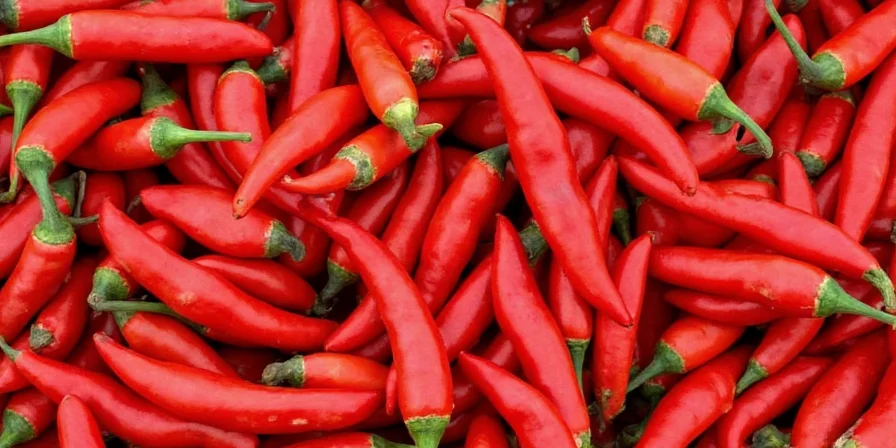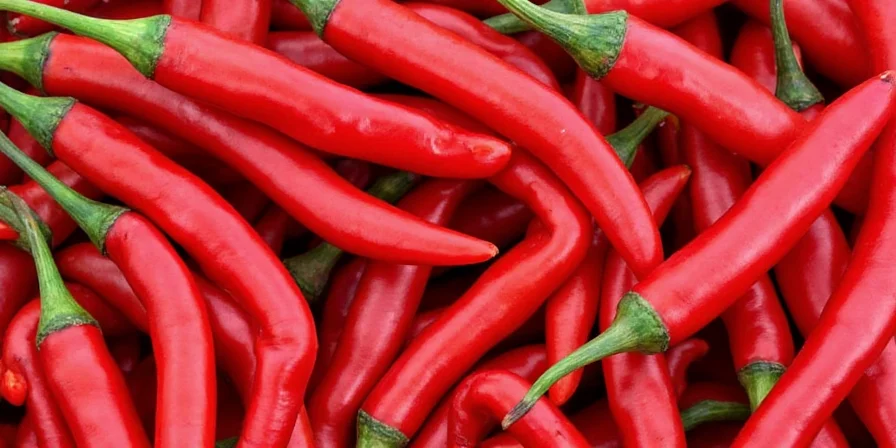Red chillies range from mild (1,000 SHU) to extremely hot (1,000,000+ SHU), with heat levels varying dramatically by variety. This complete guide reveals exactly how hot different red chillies are, which types work best for your cooking needs, and professional techniques for handling them safely. Discover heat scale comparisons, flavor profiles, evidence-based health facts, and practical usage tips trusted by chefs worldwide.
Table of Contents
- How Hot Are Red Chillis? Understanding the Heat Scale
- Most Common Red Chilli Types Compared
- How to Handle Red Chillis Safely (Without Burning)
- How to Reduce Chilli Heat in Food
- Professional Cooking Tips for Perfect Results
- Red Chilli Health Benefits: What Research Really Shows
- Debunked: Common Red Chilli Myths vs Facts
- Non-Cooking Uses You Never Knew
- Frequently Asked Questions
How Hot Are Red Chillis? Understanding the Heat Scale
Red chilli heat is measured in Scoville Heat Units (SHU), with levels varying from 500 SHU (mild paprika) to over 2,000,000 SHU (Carolina Reaper). The color change from green to red indicates ripeness, not necessarily increased heat—some red varieties are milder than their green counterparts. Heat concentration depends on:
- Genetic variety (species and cultivar)
- Growing conditions (soil, climate, water stress)
- Ripeness stage
- Plant position (top vs bottom of plant)
| Heat Level | SHU Range | Common Examples | What It Feels Like |
|---|---|---|---|
| Mild | 100-2,500 | Ancho, Paprika, Poblano | Subtle warmth, no burning sensation |
| Medium | 2,500-30,000 | Jalapeño (red), Serrano | Noticeable heat that fades quickly |
| Hot | 30,000-100,000 | Cayenne, Thai Bird's Eye | Intense burning that lingers |
| Super Hot | 100,000-2,000,000+ | Ghost Pepper, Carolina Reaper | Immediate burning with long-lasting effects |

Most Common Red Chilli Types Compared
Understanding specific varieties helps you choose the right chilli for your needs. These six types represent 90% of red chilli usage in home cooking:
| Type | Heat Level (SHU) | Flavor Notes | Best Cooking Uses |
|---|---|---|---|
| Ancho (dried poblano) | 1,000-2,000 | Smoky, raisin-like, sweet | Mole sauces, stews, chocolate dishes |
| Cayenne | 30,000-50,000 | Earthy, sharp, clean heat | Spice blends, hot sauces, rubs |
| Red Jalapeño | 2,500-8,000 | Grassy, slightly sweet | Salsas, nachos, pickling |
| Hatch Red | 1,500-8,000 | Robust, roasted flavor | Romesco, roasted dishes, sandwiches |
| Thai Bird's Eye | 50,000-100,000 | Bright, citrusy, intense | Thai curries, stir-fries, dipping sauces |
| Ghost Pepper | 800,000-1,041,427 | Smoky, floral, then brutal heat | Extreme hot sauces, challenges (use sparingly!) |
How to Handle Red Chillis Safely (Without Burning)
Super-hot varieties can cause serious discomfort if mishandled. Follow these chef-approved safety practices:
- Wear nitrile gloves (latex won't protect you) during preparation
- Avoid facial contact—never rub eyes after handling chillies
- Work near ventilation to avoid inhaling capsaicin particles
- Clean surfaces thoroughly with soapy water (alcohol spreads capsaicin)
- Use separate cutting boards for chillies to prevent cross-contamination
Emergency relief: If you burn yourself, apply whole milk (not skim) or vegetable oil to affected areas. The fat binds with capsaicin for immediate relief. Avoid water—it spreads the oil-based compound.
How to Reduce Chilli Heat in Food
Accidentally made your dish too spicy? These science-backed methods actually work:
- Add dairy: Milk, yogurt, or sour cream (the casein protein neutralizes capsaicin)
- Incorporate acid: Lemon juice or vinegar balances heat perception
- Add starch: Rice, potatoes, or bread absorb capsaicin compounds
- Include sweetness: Sugar, honey, or fruit counteracts heat receptors
- Dilute the dish: Add more non-spicy ingredients to reduce concentration
Prevention tip: Remove seeds and white membranes (placenta) where 80% of capsaicin concentrates. For milder heat with flavor, scrape these parts carefully before chopping.
Professional Cooking Tips for Perfect Results
Transform your dishes with these chef-developed techniques:
- Toast dried chillies: Dry-toast in skillet 1-2 minutes until fragrant (not burnt) to intensify flavor
- Infuse oils first: Heat oil with chillies before adding other ingredients for even heat distribution
- Rehydrate properly: Soak dried chillies in broth (not water) for 25 minutes to extract maximum flavor
- Control heat timing: Add fresh chillies late in cooking for brighter heat; early for mellow, integrated spice
- Balance with fat: Creamy elements like coconut milk tame extreme heat while enhancing flavor
Red Chilli Health Benefits: What Research Really Shows
Evidence-based health impacts when consumed in normal culinary amounts:
- Pain relief: Topical capsaicin depletes substance P, reducing neuropathic pain (per NIH studies)
- Metabolic boost: Capsaicin may temporarily increase calorie burn by 50-100 calories daily
- Cardiovascular support: Population studies show correlation with improved vascular function
- Antioxidant properties: Rich in vitamin C and carotenoids that combat oxidative stress
- Digestive adaptation: Regular consumption may improve gastric tolerance in healthy individuals
Important note: These benefits apply to moderate consumption as part of normal diet. Consult healthcare providers before using chillies for medical purposes.
Debunked: Common Red Chilli Myths vs Facts
Cut through misinformation with science-backed facts:
| Myth | Fact |
|---|---|
| Red chillies cause stomach ulcers | Ulcers are primarily caused by H. pylori bacteria; some studies suggest capsaicin may stimulate protective mucus |
| Milk makes chilli burn worse | Full-fat dairy is most effective remedy—the casein protein neutralizes capsaicin |
| All red chillies are extremely hot | Heat varies 2,000x—from mild paprika (500 SHU) to Carolina Reaper (2,200,000 SHU) |
| Spicy food damages taste buds | Taste buds regenerate every 10-14 days—temporary numbness isn't permanent damage |
| Chillies cause heartburn for everyone | Research shows they may improve gastric emptying in non-sensitive individuals |
Non-Cooking Uses You Never Knew
Practical applications beyond the kitchen:
- Natural pest control: Crushed dried chillies deter rodents and insects in gardens
- Homemade mosquito repellent: Boil chillies with water and soap for effective spray
- Reusable heat packs: Capsaicin-infused gels provide therapeutic warmth
- Eco-friendly dye: Create earth-tone fabric dyes using boiled chillies
- Compost enhancer: Spent chilli scraps add nitrogen and pest-repelling properties
Frequently Asked Questions
- How hot is a typical red chilli compared to other peppers?
- "Red chilli" isn't a single variety—it's a color stage. Heat ranges from 500 SHU (mild paprika) to 2,200,000 SHU (Carolina Reaper). Most grocery store red chillies (like jalapeños) fall in the 2,500-8,000 SHU range.
- Why are some red chillies hotter than green ones of the same type?
- As chillies ripen from green to red, sugar content increases which can enhance heat perception. However, actual capsaicin concentration varies by variety—some red forms are milder than their green counterparts.
- How can I tell how hot a red chilli is before buying?
- Look for these indicators: thinner walls = hotter, more pronounced curves = milder, smaller size = typically hotter. For specific varieties, research their typical SHU range before purchasing.
- What's the difference between red chilli powder and cayenne pepper?
- "Red chilli powder" varies by region—it may be mild paprika in some countries. Cayenne specifically refers to a 30,000-50,000 SHU pepper. Always check ingredient labels for clarity.
- How long do fresh red chillies last in the refrigerator?
- Properly stored in a paper bag in the crisper drawer, most fresh red chillies last 2-3 weeks. For longer storage, freeze whole chillies for up to 6 months.











 浙公网安备
33010002000092号
浙公网安备
33010002000092号 浙B2-20120091-4
浙B2-20120091-4